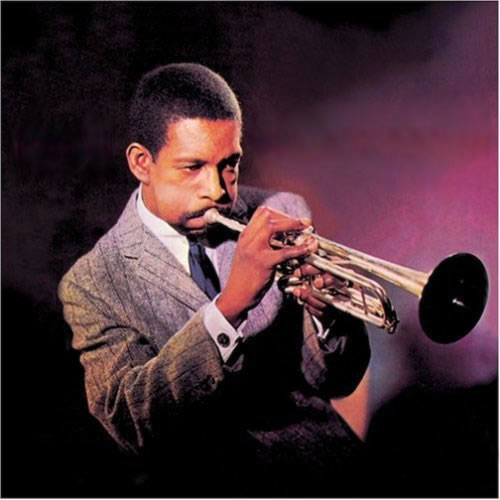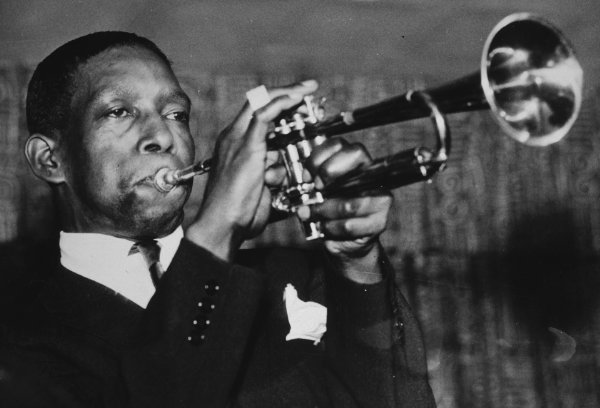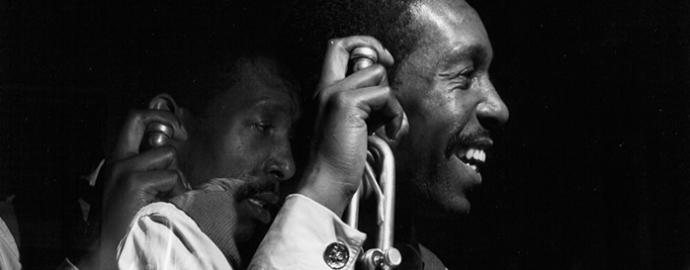 McKinley Howard “Kenny” Dorham was born on August 30, 1924 in Fairfield, Texas and passed away on December 5, 1972 in New York City at the age of 48.
McKinley Howard “Kenny” Dorham was born on August 30, 1924 in Fairfield, Texas and passed away on December 5, 1972 in New York City at the age of 48.
Born into a musical family, Dorham began playing piano at age seven and switched to trumpet while attending Anderson High School in Austin. Music was not Dorham’s only hobby as a teenager; he spent much of his time in the boxing ring as a member of the school boxing team.
Dorham briefly attended Wiley College in Marshall, Texas, where he studied chemistry and physics while performing in the dance band alongside musicians such as trumpeter “Wild” Bill Davison, saxophonist Harold Land, and drummer Roy Porter. It was in this group that Dorham first began honing his arranging and compositional skills.
Dorham was drafted into the Army in 1942 and joined their boxing team. In 1943 after his discharge, he worked with the orchestra of trumpeter Russell Jacquet, the brother of saxophonist “Illinois” Jacquet, in Houston before joining Frank Humphries’ band in 1944.
In 1946, Dorham got his first major gigs, joining the trumpet section in Dizzy Gillespie’s original big band and then replacing Fats Navarro in Billy Eckstine’s band at Diz’s recommendation.
Dorham was now associating with the most modern players on the jazz scene, recording in 1946 and 1947 with the likes of drummer Kenny Clarke, pianist Bud Powell, saxophonist Sonny Stitt, and drummer Art Blakey. He also played in the big bands of Lionel Hampton and Mercer Ellington. Dorham made his mark as an arranger as well, arranging charts for Lucky Millander (“Okay for Baby”), Benny Carter, Cootie Williams (“Malibu”), and ghosting arrangements for Gil Fuller.
In 1948, he studied composition and arranging at the Gotham School of Music under the G.I. Bill. In December 1948, Dorham got his first big break as Miles Davis recommended him as his replacement in Charlie Parker’s quintet. Dorham performed for the first time with Parker on Christmas Eve at the Royal Roost in Manhattan, with pianist Al Haig, bassist Tommy Potter, and Max Roach on drums. The gig, which was recorded, included a festive take on “White Christmas.”
Dorham stayed with Parker into 1949, recording on one of the altoist’s most solid Verve sessions, which produced the tracks “Passport,” “Visa,” “Segment,” and “Cardboard.” Following their return from the Paris Jazz Fair at the end of May 1949, Dorham was replaced by Red Rodney. He returned to Parker’s group intermittently as a replacement over the next few years, notably on March 4th, 1955 at Birdland: Parker’s final performance before his untimely death seven days later.
Finding it difficult to make a living as a jazz trumpeter, Dorham moved to California from 1950 to 1952, where he worked day jobs. He then moved back east, settled in New York and began freelancing, working with the likes of Bud Powell, Sonny Stitt, and Mary Lou Williams. He recorded with Thelonious Monk on May 30, 1952, on tracks which ended up on Monk’s release, Genius of Modern Music Volume 2. He led his first session as a leader on December 15th,1953, with Jimmy Heath on saxophone, Walter Bishop on piano, Percy Heath on bass, and drummer Kenny Clarke, which was released by Debut as Kenny Dorham Quintet.
Work followed with altoist Lou Donaldson and tenorman Sonny Rollins before Dorham replaced Clifford Brown in Horace Silver and Art Blakey’s Jazz Messengers, recording their co-led hard-bop classic Horace Silver and the Jazz Messengers album for Blue Note in November 1954 and February 1955.
 Dorham’s fleet lyricism is showcased on “Hankerin’,” his running style and taste for melodic logic on “The Preacher,” and he blows some of his best blues choruses on Silver’s funky classic “Doodlin.’” Dorham also plays spiritedly on The Jazz Messengers at Café Bohemia Vols. 1-3, which was recorded on November 23rd, 1955.
Dorham’s fleet lyricism is showcased on “Hankerin’,” his running style and taste for melodic logic on “The Preacher,” and he blows some of his best blues choruses on Silver’s funky classic “Doodlin.’” Dorham also plays spiritedly on The Jazz Messengers at Café Bohemia Vols. 1-3, which was recorded on November 23rd, 1955.
Dorham also recorded what many believe was his greatest album for Blue Note in 1955, Afro-Cuban. Recorded in two sessions, on January 30, 1955 with a sextet, and March 29,1955 with a nonet, this album showcases Dorham’s interest in combining Latin music with jazz and his distinct compositional and arranging skills. It also features a who’s who of Blue Note hard-boppers—Hank Mobley, Cecil Payne, J.J. Johnson, Art Blakey, Horace Silver, Percy Heath and Oscar Pettiford. “La Villa,” taken from the sextet session, features fine blowing by all.
Dorham led a short-lived group called the Jazz Prophets in 1956 which featured J.R. Montrose on tenor sax, Sam Jones on bass, Arthur Edgehill on drums, and Dick Katz on piano, who was later replaced by Bobby Timmons. The group recorded for Blue Note at the Café Bohemia and three albums were released under Dorham’s name:‘Round About Midnight at the Café Bohemia Vols. 1-3. Dorham also recorded in 1956 with the likes of Tadd Dameron, Phil Woods, Cecil Payne, Matthew Gee, Hank Mobley, Sonny Rollins, Gil Melle, and Ernie Henry.
After Clifford Brown’s tragic death in a car accident in September of 1956, drummer Max Roach called upon Dorham to replace the great trumpeter in his quintet. Dorham stayed with Roach for nearly two years, and is heard on Jazz in 3/4 Time (which features the trumpeter alongside Sonny Rollins on “Blues Waltz” and “Lover,” Max Roach + Four, Max Roach 4 Plays Charlie Parker, and Max.
Dorham’s own Jazz Contrasts was recorded in 1957, teaming him with Roach frontline mate Sonny Rollins on “I’ll Remember April” and also accompanied on half of the tracks by harpist Betty Glamann. After the Roach group disbanded, Dorham recorded some memorable albums as a leader in 1958 and 1959, including his pristine Quiet Kenny, which featured “Blue Spring Shuffle,” and even a vocal album, Kenny Dorham Sings and Plays: This Is the Moment.
Dorham also performed on one of the more unusual albums of the 1950s alongside John Coltrane and the avant-gardist Cecil Taylor, who forces his uncompromising, vigorous piano playing into an otherwise hard-bop-oriented affair. The uneven album would be ultimately released on Blue Note as Coltrane Time in 1962. Other session work included dates with Abbey Lincoln, Betty Carter, Jackie McLean, Oliver Nelson, and Eric Dolphy.
In 1961, Dorham recorded the fantastic album Whistle Stop for Blue Note. In 1963, he began a prolific partnership with tenorman Joe Henderson. The trumpeter was an early proponent of the young tenorist, and his brilliant Una Mas was Henderson’s first recording session. Dorham was now associating with musicians over ten years his junior, and their forward-thinking ways pushed the trumpeter into greater, more daring territory. In particular, Henderson’s harmonically adventurous improvisations forced Dorham to intensify his own playing and include more open modal structures within his compositions.

“Una Mas” featured Herbie Hancock, Butch Warren, and Tony Williams in the rhythm section, backing Dorham as he blows one of his more aggressive and bold statements on record. Dorham’s most lasting contribution to the jazz canon, “Blue Bossa,” was the opening track on Henderson’s first album as a leader, Page One. Henderson’s Our Thing followed in 1963, which featured a swinging title track, and his In ‘n Out was recorded in 1964.
The intrepid pianist Andrew Hill requested both Henderson and Dorham’s services on his breakout, avant-garde Blue Note masterpiece Point of Departure in 1964. Now nearly forty years old, Dorham is audibly pushing himself in the company of these younger progressives, deeply investigating the possibilities inside Hill’s ambiguously open harmonies with intense arpeggios, repeated intervals and contrasting lyrical flurries. Listen to his edgy improvisation on the fiery “Refuge.”
Dorham recorded his final session as a leader, Trumpet Toccata, later that year. He became less active into the later 1960s and as he again found it difficult to make a living playing jazz trumpet; he found work at times at a sugar refinery, the post office, and medical plants. He recorded with Cedar Walton, Toshiko Akiyoshi, Barry Harris, and Clifford Jordan in the late 1960s while also writing record reviews for Down Beat magazine.
Dorham continued to study music at New York University, was a consultant for the Harlem Youth Act anti-poverty program, and held a position on the board of the of the New York Neophonic Orchestra. By 1970, his health began to seriously deteriorate and a kidney ailment forced him into fifteen hours of weekly dialysis at a local hospital. He died on December 5, 1972 of kidney failure.